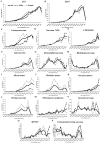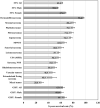Descriptive epidemiology of soft tissue sarcomas and gastrointestinal stromal tumors in Thailand
- PMID: 35896585
- PMCID: PMC9329344
- DOI: 10.1038/s41598-022-15711-8
Descriptive epidemiology of soft tissue sarcomas and gastrointestinal stromal tumors in Thailand
Abstract
This study aimed to analyze burden of STS and GIST in population and survival rate which represented the current situation of treatment in Thailand. The data was collected from five population-based cancer registries around the country for the period 2001 through 2015. The Segi world standard population was used to calculated age-standardized incidence rates (ASR). Standardized rate ratios (SRR) were used to compare populations. Joinpoint Trend Analysis was used to assess changes in incidence. STATA was used to examine patient survival rates. During the study period, 4080 cases of STS and 457 cases of GIST were reported. The ASR of STS and GIST was 2.14/100,000 person-years and 0.22/100,000 person-years, respectively. The most common histological types of STS were unspecified sarcoma (24.8%), leiomyosarcoma (19.0%) and liposarcoma (11.4%). The overall ASR of STS in Thailand was relatively low compared to Western countries. The five-year survival rate was 62.6% for STS and 63.4% for GIST, which was comparable to the rates reported in other countries. This is the first report of STS and GIST from PBCRs in Thailand. Based on current healthcare service, an overall survival rates of STS and GIST are comparable to those reported from others.
© 2022. The Author(s).
Conflict of interest statement
The authors declare no competing interests.
Figures


Similar articles
-
An analysis of the incidence and survival rates of bone sarcoma patients in thailand: reports from population-based cancer registries 2001-2015.Cancer Epidemiol. 2022 Feb;76:102056. doi: 10.1016/j.canep.2021.102056. Epub 2021 Nov 16. Cancer Epidemiol. 2022. PMID: 34798388
-
Incidence and time trends of sarcoma (2000-2013): results from the French network of cancer registries (FRANCIM).BMC Cancer. 2020 Mar 6;20(1):190. doi: 10.1186/s12885-020-6683-0. BMC Cancer. 2020. PMID: 32138705 Free PMC article.
-
Soft Tissue Sarcomas: A 16-Year Experience of a Tertiary Referral Hospital in North Jordan.Medicina (Kaunas). 2022 Jan 27;58(2):198. doi: 10.3390/medicina58020198. Medicina (Kaunas). 2022. PMID: 35208522 Free PMC article.
-
Current Concepts in Non-Gastrointestinal Stromal Tumor Soft Tissue Sarcomas: A Primer for Radiologists.Korean J Radiol. 2017 Jan-Feb;18(1):94-106. doi: 10.3348/kjr.2017.18.1.94. Epub 2017 Jan 5. Korean J Radiol. 2017. PMID: 28096721 Free PMC article. Review.
-
Prognostic factors in soft tissue sarcoma.Dan Med J. 2014 Nov;61(11):B4957. Dan Med J. 2014. PMID: 25370967 Review.
Cited by
-
Diagnostic and Therapeutic Benefits of Intra-operative Enteroscopy in Epithelioid Angiosarcoma of the Small Intestine.Cureus. 2023 Jan 22;15(1):e34056. doi: 10.7759/cureus.34056. eCollection 2023 Jan. Cureus. 2023. PMID: 36824541 Free PMC article.
References
-
- Fletcher CD, Unni KK, Mertens F. Pathology and Genetics of Tumours of Soft Tissue and Bone. Iarc; 2002.
-
- American Cancer Society. What is a soft tissue sarcoma? Available: https://www.cancer.org/cancer/soft-tissue-sarcoma/about/soft-tissue-sarc.... (Accessed 28 June 2020).
-
- Fletcher C, Bridge JA, Hogendoorn PCW, Mertens F. WHO Classification of Tumours of Soft Tissue and Bone: WHO Classification of Tumours. World Health Organization; 2013.
-
- Toro JR, et al. Incidence patterns of soft tissue sarcomas, regardless of primary site, in the surveillance, epidemiology and end results program, 1978–2001: An analysis of 26,758 cases. Int. J. Cancer. 2006;119:12. - PubMed
Publication types
MeSH terms
LinkOut - more resources
Full Text Sources
Medical

